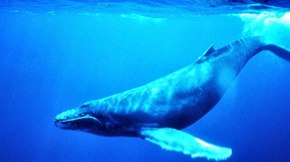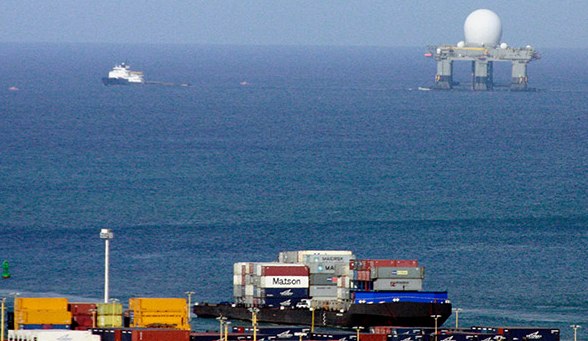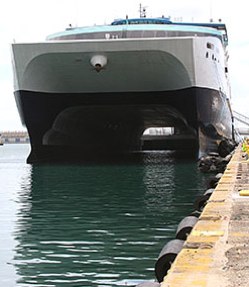Blog
News, updates, finds, stories, and tidbits from staff and community members at KAHEA. Got something to share? Email us at: kahea-alliance@hawaii.rr.com.
That Deafness? It's Only Temporary.

Many of you followed the sonar lawsuit from 2008, in which KAHEA, in partnership with Earthjustice and other local, national and international NGOs, sued the U.S. Navy over its proposed expansion of military exercises around Hawai’i, including the Northwestern Hawaiian Islands. The State of Hawai’i, at our urging, also asked the Navy to comply with laws protecting endangered species in Hawai’i. Not surprising, the Navy refused.
Now, there’s another round of public scoping hearings for more sonar and more detonations. But don’t worry about those whales. According to the U.S. Navy, the deafness caused by underwater explosions and sonar is only temporary.
An update on U.S. Navy training in Hawaiian waters, from the Hawaii Independent:
The U.S. Navy announced its intent to prepare an Environmental Impact Statement (EIS) and Overseas EIS (OEIS) relating to military training and research, including sonar and detonating explosives, within the Hawaii-Southern California Training and Testing (HSTT) study area.
Public scoping meetings throughout Hawaii have been scheduled to hear comments. Last year, the federal government issued authorization to the U.S. Navy to impact whales and dolphins while conducting sonar training exercises around the main Hawaiian Islands for five years, Environmental News reported.
The letter of authorization and accompanying rules allow for injury or death of up to 10 animals of each of 11 species over the five years covered by the regulations. The Navy requested authorization under the Marine Mammal Protection Act because the mid-frequency sound generated by tactical active sonar, and the sound and pressure generated by detonating explosives, may affect the behavior of some marine mammals or cause what the Navy calls “a temporary loss of their hearing.”
Mid-frequency sonar can emit continuous sound well above 235 decibels, an intensity roughly comparable to a rocket at blastoff, according to Environmental News.
The sonar blasts travel across hundreds of miles of ocean to reveal objects, such as submarines, underwater. The National Marine Fisheries Service (NMFS) will be a cooperating agency in preparation of this EIS and OEIS. In January 2009, the NMFS’s ruling stated: “After reviewing the current status of the endangered blue whale, fin whale, humpback whale, sei whale, sperm whale, Hawaiian monk seal, green sea turtle, leatherback sea turtle, loggerhead sea turtle, and Pacific ridley sea turtle, … [Navy training activity in the Hawaii Range Complex] each year for a five-year period beginning in January, 2009, are likely to adversely affect but are not likely to jeopardize the continued existence of these threatened and endangered species under NMFS’s jurisdiction.”
While Earth Justice wants the Navy to stop using sonar until it can avoid serious injury to marine mammals, the environmental group recommends several things the Navy can do to minimize the harm to marine life: Impose seasonal and geographical limitations, avoid nursing areas, ramp sonar up slowly, avoid areas that were created specifically to protect endangered marine life, create a 25-mile safe haven distance from shorelines, avoid steep-sloping seamounts that provide important habitat for many marine species, prohibit testing at night or other times of low visibility, and adopt protocols similar to those of other naval forces to minimize the impact on marine wildlife.
The Navy’s latest proposed action is to conduct training and testing activities within the at-sea portions of existing Navy training range complexes around the Hawaiian Islands and off the coast of Southern California. Training activities, such as sonar maintenance, explosives, and gunnery exercises, may occur outside of Navy operating and warning areas. In 2009, the Navy instituted mitigation measures relating to sonar that include stationing lookouts, adjusting sonar decibel levels when marine animals are detected within 200 to 1,000 yards, and increased visual and aerial surveillance for marine life. The HSTT study area combines the at-sea portions of the following range complexes: Hawaii Range Complex, Southern California Range Complex, and Silver Strand Training Complex. The existing western boundary of the Hawaii Range Complex is being expanded 60 miles to the west to the International Dateline.
The HSTT study area also includes the transit route between Hawaii and Southern California as well as Navy and commercial piers at Pearl Harbor and in San Diego, CA where sonar may also be tested.
Public scoping meetings will be held between 4:00 p.m. and 8:00 p.m.
- Tuesday, August 24, 2010, Kauai Community College Cafeteria, 3-1901 Kaumualii Highway, Lihue, HI.
- Wednesday, August 25, 2010, Disabled American Veterans Hall, Weinberg Hall, 2685 North Nimitz Highway, Honolulu, HI.
- Thursday, August 26, 2010, Hilo High School Cafeteria, 556 Waianuenue Avenue, Hilo, HI. 6. Friday, August 27, 2010
- Maui Waena Intermediate School Cafeteria, 795 Onehee Avenue, Kahului, HI.
The meetings will consist of an informal, open house session with informational stations staffed by Navy representatives. Additional information concerning meeting times is available on the EIS and OEIS website at http://www.HawaiiSOCALEIS.com. The scoping process will be used to identify community concerns and local issues to be addressed in the EIS and OEIS. All comments provided orally or in writing at the scoping meetings, will receive the same consideration during EIS and OEIS preparation. Written comments must be postmarked no later than September 14 and should be mailed to: Naval Facilities Engineering Command, Southwest, 2730 McKean Street, Building 291, San Diego, CA 92136-5198, Attention: Mr. Kent Randall—HSTT EIS/OEIS.
No Plans to Clean Up Depleted Uranium, Army Says
Mahalo again to Alan McNarie for excellent investigative piece on Depleted Uranium (DU). Schofield Barracks (O’ahu) and Pohakuloa Training Area (Hawai’i Island) are main areas where DU is a concern, but the Army has also admitted that there may be DU at Makua (O’ahu).
According to a high Army official, the Army never intended to remove depleted uranium ammunition remnants from Pohakuloa Training Area and Shofield Barracks, and it has no plans to do so for as long as the firing ranges at those facilities are still in use.
See the full article in the Big Island Weekly at: http://bigislandweekly.com/articles/2010/06/30/read/news/news02.txt
Hawaiʻi Undersea Military Munitions Assessment
Video and article on the Hawai’i Undersea Military Munitions Assessment–the search to find legacy dumped munitions around Hawai’i, in the UH Malamalama: “…the first study of possible chemical weapons sites in Hawaiʻi and the most comprehensive study ever taken in U.S. waters…”
http://www.hawaii.edu/malamalama/2010/04/underwater-ordnance/
Got Input for the Army on its Environmental Investigations? Apply by August 14!
From: Andrea
U.S. Army Garrison-Hawaii is soliciting community interest in creating a Restoration Advisory Board as part of the Military Munitions Response Program for two sites near the U.S. Army’s Pohakuloa Training Area. The motivation for the Restoration Advisory Board is to enable community participation in environmental issues on previously used military training sites.
Currently, the focus of the Restoration Advisory Board would be the remedial investigation of two response sites: the closed Humuula Sheep Station and the Kulani Boys’ Home.
The Board will be formed if enough community interest is expressed. The Board would be composed of community members, government representatives, and other stakeholders. The Board members would attend meetings and review and comment on plans and reports related to the investigation.
For more information or to request an application, contact:
Environmental Divison
MMRP Program Manager
Director of Public Works, USAG-HI
948 Santos Dumont Ave.
Building 105, 3rd Floor, WAAF
Schofield Barracks, HI 96857
Phone: 808-656-3109
Fax: 808-656-1039
*Applications must be postmarked or emailed by August 14!
They're not aiming for Palau...
From Miwa:

From the NY Times, “Hawaiians Shrug off Missile Threat“:
Now the Obama administration says North Korea could launch a ballistic missile in the state’s direction — possibly around the Fourth of July, according to the Japanese news media — prompting the United States military to strengthen defenses here…
People took comfort in the heavy, year-round military presence provided by several bases here but also wondered if it made the state more of a target.
Yes, it’s called irony, folks. And it’s why they aren’t aiming for Palau.
Taken for a Ride
The excellent Chris Pala has a great investigative piece in today’s Honolulu Weekly on the “why” of Superferry: “Now that the Hawai‘i Supreme Court has freed them of any obligation to serve the Islands, which has proved to be a money-losing operation, are they going to fetch a better price elsewhere? If they do, was that the main point for building them and bringing them here?”
See the full article at: http://honoluluweekly.com/feature/2009/03/conspiracy-ferry/

Will Proposed Army Studies on DU Tell Us What We Need to Know?
Excerpt from Letter to the U.S. Army from Michael Reimer in regards to Depleted Uranium (DU) studies at Schofield Barracks, on Oahu, and Pohakuloa Training Area (PTA), on Hawaii:
Colonel Howard Killian, Deputy Director
U.S. Army Installation Management Command
Pacific Region
132 Yamanaga Street
Fort Shafter, Hawaii 96858-5520Dear Colonel Killian:
I have had an opportunity to review the reports released from DU studies at Schofield Barracks and Pohakuloa Training Area. I also spoke with Dr. Lorrin Pang, some members of the Community Advisory Group, and met contractor Dr. Jeff Morrow.
I agree with your statement that you mentioned in a previous communication we had, and that is to let the science speak.
In that light, I am particularly concerned that what is proposed by the U.S. Army for future studies at PTA will fall far short of providing the best information possible at this time, or for that matter, provide any information that can be used to develop a real rather than a speculative risk assessment.
DU is an issue of evolving study results and knowledge. There are some points that are immutable fact. We know that DU is present at Schofield and Pohakuloa. As I recall, the Army does not dispute the point of potential health risk. Therefore, we must take the best information we obtain today and use it to address the concerns about the level of health risks from potential exposure to DU.
The citizens of the Big Island are concerned. This is a natural, often fearful, reaction anytime the word radiation is mentioned in our society. Yet, we live in a world with ubiquitous and unavoidable natural radiation, from cosmic rays to the foodstuffs that provide our sustenance. According to the position of the U.S. EPA, any and all ionizing radiation has the potential of causing cancer. Thus, there has to be a reasoned balance between unavoidable exposure and elective exposure.
The past use of DU on the Big Island places exposure to that type of radioactive material in the “unavoidable exposure” category. This brings forth the question then of how much additional risk does it pose to the people of the Big Island including the military personnel stationed and working at Pohakuloa.
I believe that with adequate study, this question can be answered with reasonable assurance. As I mentioned, I do not believe the currently planned study has the capacity to answer that question. The reason for my belief is that the study design is to measure total uranium and to show that it is below standards set by World Agencies for regulated exposures. This may present itself as a feel-good approach, but it is unfortunately misleading even with the rudimentary information we have today about the form and occurrence of uranium in the natural environment. In other words, the study as currently planned still leaves the door wide open on determining excess health risks, if any.
Michael Reimer, Ph.D., geologist, retired
Kona Hawaii, Hawaii
Mahalo to Shannon for the tip. shannonkona@gmail.com





